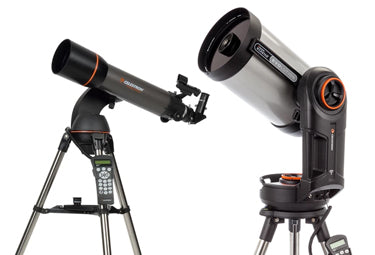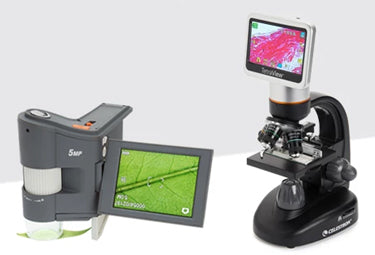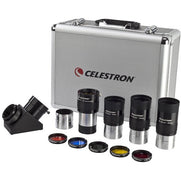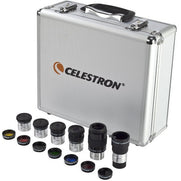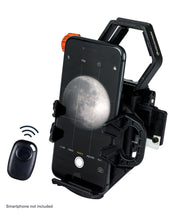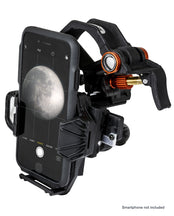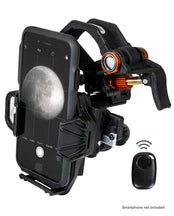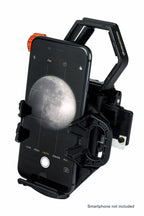The Ultimate Guide to Observing Mars
August 27, 2020

Beyond Earth's orbit lies the fourth planet from the Sun, Mars—a small, mysterious world that has intrigued humanity for generations. With its fiery, reddish appearance in the night sky, Mars often looks like it is preparing for battle, so it was fittingly named for the Roman god of war.
This guide will help you understand Mars and why it is such a favorable target for amateur astronomers and astroimagers of all skill levels. You’ll find below the key dates for 2025 (oppositions, occultations, and conjunctions), followed by observing techniques, gear recommendations, and Mars facts.
Important 2025 Dates and Sky Events
Mars Opposition
- Date: January 16, 2025
- Constellation: Gemini
- Apparent Diameter & Brightness: ~14.5 arcseconds in diameter, shining at magnitude -1.4
-
Significance: Opposition occurs about every 26 months when Earth catches up to Mars in their respective orbits, placing Earth between the Sun and Mars. From our perspective, Mars rises as the Sun sets and remains visible all night.
Lunar Occultation of Mars

-
January 13, 2025 (Full Moon): The Moon will pass in front of Mars. This occultation is visible from parts of the Americas and Africa. Outside the occultation boundary, observers can still enjoy a close conjunction.

- February 9, 2025: Another lunar occultation of Mars will occur over high latitudes (portions of Russia, China, Canada, and Greenland), though it will not be seen from the United States.
Notable Mars Conjunctions

- October 21, 2025: Mars and Mercury: The two planets will be separated by about 2 degrees, low in the southwest after dusk.
- November 12, 2025: Mars and Mercury again: An even closer conjunction—about 1.18 degrees apart—also low in the southwest after dusk.
Why Observe Mars?
Unlike Venus and the outer planets covered in clouds, Mars shows surface detail when viewed through a telescope. Nineteenth-century astronomers noticed lines resembling irrigation "canals" and ever-changing seasonal polar ice caps. These markings caused some to speculate that there could be intelligent life on the planet. Although today we know there are no “little green men” on Mars, it remains a fascinating world to explore with your telescope. Best of all, you can do it right from your backyard—even under light-polluted skies!
What is Mars Opposition, Anyway?
Mars opposition happens when Earth lines up directly between the Sun and Mars. During opposition, which only occurs about once every 26 months, Mars rises in the east at sunset and is visible all night.
Close oppositions happen every 15-17 years, when Mars is near perihelion (its closest point to the Sun in its orbit).
- In 2003, Earth and Mars were just under 35 million miles apart—the closest in ~60,000 years, with Mars appearing 25 arcseconds wide at magnitude -2.8.
- Less favorable oppositions can be ~62 million miles away, resulting in smaller apparent size.

How to Find Mars in the Night Sky
If you’ve been following Mars since a previous opposition, you’ll have tracked it through different constellations. For everyone else, star charts in astronomy magazines or websites are helpful. Astronomy apps like Celestron’s SkyPortal Powered by SkySafari™ (included with every Celestron telescope purchase!) are the most comprehensive and informative tools for real-time updates on Mars’ position, 24/7. SkyPortal offers written and audio descriptions of Mars, a responsive planetarium interface that you can hold up to the sky for instant identification, rise/set times, coordinates, and physical/orbital parameters for Mars.

The Best Equipment for Viewing Mars
Because Mars is a bright planet, you don’t need to travel to a remote dark-sky site or purchase a lot of specialized gear for thrilling views. When Mars is visible, simply head outside with any optical aid and gaze at our neighboring world. Of course, a bigger budget will get you a larger image scale and enhance the appearance of surface detail, but don’t wait to start observing until you have the “perfect” piece of equipment. Mars is there for all of us to enjoy!
Telescopes
You may be surprised to learn that even a small entry-level or travel telescope (60-90mm in aperture) has enough light-gathering ability to reveal some surface markings on the Red Planet. Remember, though, that image scale will be small.
Stepping up to a Schmidt-Cassegrain or Maksutov-Cassegrain with 7” or more in aperture will deliver noticeably better views thanks to its increased light-gathering ability and longer focal length, which boosts image scale and resolution. When purchasing a larger telescope, consider how much weight you want to carry. For a backyard target like Mars, choose something you can set up quickly when conditions are good.
Filters
Added to any telescope, filters enhance subtle features on the Martian surface and in its atmosphere:
- #80A Blue Filter: Highlights atmospheric clouds.
- #58 Green Filter or#56 Light Green Filter: Boosts contrast of polar caps, low clouds, and dust storms.
- #25 Red Filter: Sharpens polar caps and surface features, outlines dust clouds.
- #21 Orange Filter or#12 Yellow Filter: Increases contrast between light/dark surface features, sharpens dust cloud boundaries.
- Variable Polarizing Filter: Adjusts light transmission to reduce glare.
You can purchase a variety of filters at once with a Celestron accessory kit (#94306, #94307, #94308, #94119-10, #94303, #94305):
What are the different types of eyepiece filters: Colored, Neutral Density and Polarizing? Read More
Cameras and Phone Adapters
Capturing Mars on camera has never been more accessible. Whether you want a quick snapshot with your smartphone or a detailed image or time-lapse video, there’s a camera setup for every skill level and budget. Below are the three most popular options—smartphones, DSLRs, and dedicated planetary cameras—along with basic steps and recommended accessories for each:
-
Capturing Mars with your Smartphone
You can try holding your smartphone to your telescope’s eyepiece and capturing a shot. But because of the small image scale, it can be challenging to align your phone’s camera with the eyepiece. Instead, try adding a smartphone adapter like the Basic Smartphone Adapter #81035 or NexYZ 3-Axis #81055 for stability. These simple devices clamp onto the telescope’s eyepiece and allow you to precisely line up your shot. Once you’ve centered Mars, you can use your phone’s digital zoom to enlarge Mars for more impact.
-
Capturing Mars with your DSLR Camera
Using a DSLR camera is another easy way to capture images of Mars through your telescope. You just need two very inexpensive pieces of equipment to make it happen: a T-Adapter (which comes in various models depending on your telescope’s design) and a camera-specific T-ring (made for Canon, Nikon, or other brands). First, attach the T-ring to your DSLR camera’s lens mount just like you would a normal lens. Then, thread the T-Adapter onto the T-ring. Finally, attach the T-Adapter assembly to your telescope’s focuser or rear cell. Now, with your DSLR at the telescope’s prime focus, you’ve essentially turned your telescope into a massive telephoto lens—allowing you to record images of the Martian surface.
-
Capturing Mars with a Planetary Camera
For those seeking higher magnification and detail, a dedicated planetary imaging camera is an excellent choice. These specialized cameras replace the telescope’s eyepiece, sending a live video feed directly to your computer via USB. Planetary imaging software then analyzes each frame of video, filters out frames distorted by atmospheric turbulence, and stacks the clearest images to create a single, crisp composite. This process reveals subtle Martian features such as dust storms, faint surface markings, and even glimpses of the planet’s polar caps. Celestron’s NexImage 5 (#93711) is an affordable, high-quality camera that can deliver impressive results.
To browse a full assortment of Celestron telescopes and accessories that will make your Mars viewing and imaging experience more enjoyable, click here.
What to Look for While Observing Mars
|
 |
Phases Mars appears mostly in a gibbous phase, reaching “full” at opposition (unlike Venus’ full range of phases). |
|
 |
Polar Ice Caps Composed of CO₂ (dry ice) over water ice; vary with the seasons. |
 |
Land Formations
|
 |
Dust Storms May obscure many surface features. Major storms can become global and last weeks. |
|
Moons (Phobos & Deimos)
|
Observing Challenge: Very tiny and close to bright Mars; you’ll need an 11" or larger telescope, excellent conditions, and patience. |
Helpful Observing Hints
|
Tip #1: |
>
|
|
Tip #2: |
|
|
Tip #3: |
|
| Tip #4: Observe Often |
|
Interesting Facts About Mars
|
 |
The Red Planet Mars is often called the "Red Planet" because of its reddish appearance, caused by iron oxide (rust) on its surface. |
 |
Roman Mythology Mars was the god of war and agriculture and the protector of Rome. |
 |
Size and Distance
|
 |
Martian Days and Years
|
 |
Seasons
|
 |
Surface Features
|
 |
Moons
|
 |
Water on Mars
|
 |
Atmosphere
|
 |
Clouds
|
 |
Martian Dust Storms
|
 |
Martian Dust Devils
|
Human Exploration and the Future of Mars

We hope this guide helped you get better acquainted with the Red Planet. As you observe Mars, remember that rovers originally from Earth are currently exploring its dusty plains, while orbiters circle overhead.
Indeed, Mars is one of the most thoroughly explored planets. Since 1965, missions like Mariner 4, Viking 1 & 2, Pathfinder/Sojourner, Mars Global Surveyor, Spirit & Opportunity, Mars Reconnaissance Orbiter, Curiosity, InSight, Perseverance & Ingenuity, Tianwen-1, and the Hope Orbiter have significantly advanced our understanding of this intriguing world.
With future human missions, Mars may soon reveal even more of its long-held secrets. Will it confirm evidence of past (or present) life? Only time will tell. Until then, enjoy your journey exploring Mars—from your backyard or anywhere else under clear skies!
Other articles you might be interested in: Ultimate Guide to Observing the Universe




